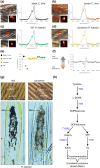The Role of Two Tyrosinase-Like Glycoenzymes in Defining the Final Hue of Parrot Plumage
- PMID: 40195888
- PMCID: PMC11976374
- DOI: 10.1111/pcmr.70010
The Role of Two Tyrosinase-Like Glycoenzymes in Defining the Final Hue of Parrot Plumage
Abstract
Recent advances in avian melanogenesis have pinpointed multiple genetic loci associated with color polymorphisms, predominantly in the plumage of chickens, quails, and pigeons. However, the genetic basis of melaninization in parrot plumage remains elusive. Previously, we showed that mutations in the melanosomal ion-transporter SLC45A2 lead to a complete loss of blue structural color in green parrot feathers, leaving only yellow psittacofulvin. Yet, several color morphs involving partial or complete melanin reduction are common in captive-bred parrots that have not been studied. To bridge this gap, we investigated two new color morphs of parrot plumage: non-sex-linked recessive lutino (NSL), which entirely inhibits blue structural coloration, and the sex-linked recessive cinnamon, which reduces the intensity of blue structural coloration. Our genotypic analysis revealed that tyrosinase (TYR) variants are responsible for the NSL phenotype in Fischer's lovebird and green-cheeked parakeet, while tyrosinase related protein 1 (TYRP1) variants are associated with the cinnamon phenotype in the rose-ringed parakeet. When transfected into HEK293T cells, the candidate substitutions significantly affected tyrosinase enzymatic activity. This study underscores tyrosinase and related enzymes' role in parrot feather coloration, enhancing our understanding of avian melanogenesis as well as the conserved functions of melanogenic components across different species.
Keywords: TYR; TYRP1; eumelanin; feather; parrot.
© 2025 The Author(s). Pigment Cell & Melanoma Research published by John Wiley & Sons Ltd.
Conflict of interest statement
The authors declare no conflicts of interest.
Figures





References
MeSH terms
Substances
Grants and funding
LinkOut - more resources
Full Text Sources
Research Materials
Miscellaneous

